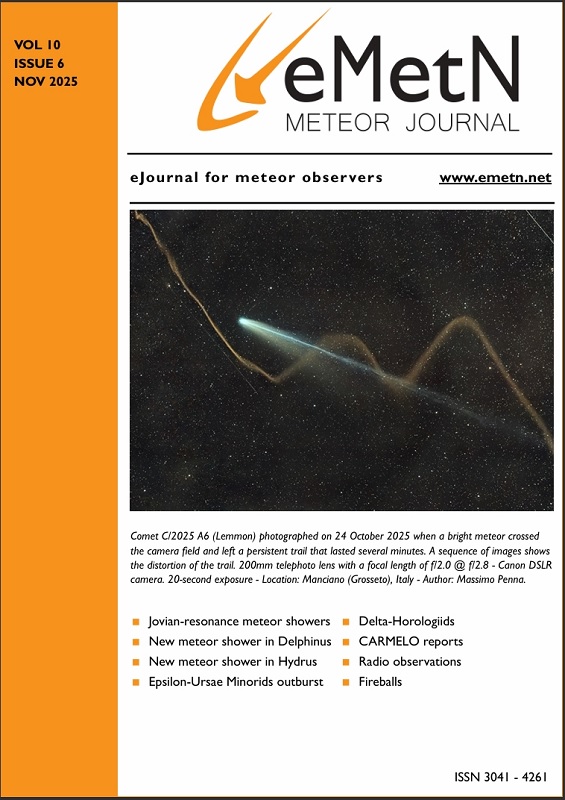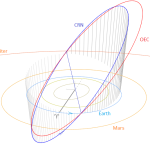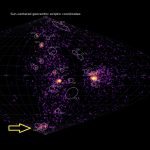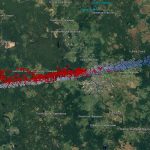Lorenzo Barbieri (CARMELO network and AAB, Associazione Astrofili Bolognesi)
Mariasole Maglione (GAV, Gruppo Astrofili Vicentini)
Introduction
In September, the meteor activity detected by the CARMELO network was moderate and did not allow us to highlight peaks in the activity of specific showers. We therefore decided to take this opportunity to think about the possibility of evaluating, at least qualitatively, the behavior of meteor showers based on the network data.
Methods
The CARMELO network consists of SDR radio receivers. In them, a microprocessor (Raspberry) performs three functions simultaneously:
- By driving a dongle, it tunes the frequency on which the transmitter transmits and tunes like a radio, samples the radio signal and through the FFT (Fast Fourier Transform) measures frequency and received power.
- By analyzing the received data for each packet, it detects meteoric echoes and discards false positives and interference.
- It compiles a file containing the event log and sends it to a server.
The data are all generated by the same standard, and are therefore homogeneous and comparable. A single receiver can be assembled with a few devices whose total current cost is about 210 euros.
To participate in the network read the instructions on this page.
September data
In the plots that follow, all available at this page, the abscissae represent time, which is expressed in UT (Universal Time) or in solar longitude (Solar Long), and the ordinates represent the hourly rate, calculated as the total number of events recorded by the network in an hour divided by the number of operating receivers.
In fig.1, the trend of signals detected by the receivers for the month of September.
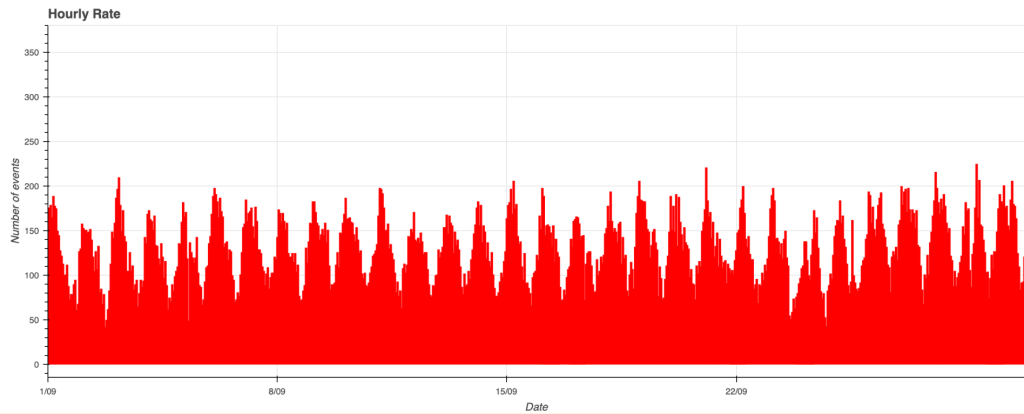
Fig. 1: September 2025 data trend.
In September, meteor activity recorded by the CARMELO network was more or less constant. There were no peaks in activity associated with any particular meteor shower.
The behavior of meteor showers
As we have already seen, amateur observation of meteors using radio meteor scatter suffers from the serious limitation of not being able to define orbits. As a result, it is impossible to classify individual meteors.
On the other hand, as is well known, this type of observation is independent of weather conditions and the presence or absence of the Sun or Moon. It can therefore be useful in assessing, at least qualitatively, the behavior of meteor showers. Let us therefore try to hypothesize a use of CARMELO data for this purpose.
Let us assume that a meteor shower, at the moment of its formation, has a homogeneous structure, i.e., that the particles that compose it are uniformly distributed within the cylinder created by the release of matter from the parent body.
As is well known, over time this homogeneity is lost due to certain perturbing forces. The best known of these is the Poynting-Robertson effect. This effect can be explained by the fact that particles heated by the Sun tend to cool down by re-emitting the same energy in the infrared, in all directions.
By examining the average behavior of all particles, thus attributing spherical symmetry to them, if the particle were stationary, the radiation emitted would be the same in all directions, with equal quantity and equal frequency.
However, all particles travel in the Solar System at a speed of about 30 km/s, so in the direction of travel, the frequency of the radiation emitted is higher than that emitted in the opposite direction, due to the Doppler effect. (1)
According to Planck’s law, the famous law underlying quantum mechanics:
![]()
Where e is energy, h is Planck’s constant, and 𝜈 is frequency.
The energy released in the direction of travel is greater than that released in the opposite direction: it follows, therefore, that the particle undergoes a braking action. This braking action will not be the same for all particles, but will be proportional to their ability to receive and re-emit heat and therefore, among other quantities, to their mass.
The more a body is slowed down, the more its orbit ‘tightens’, i.e. the axes of the orbit become smaller. It follows that different particles are induced by the Poynting-Robertson effect to differentiate their orbits according to their mass (see fig. 2).
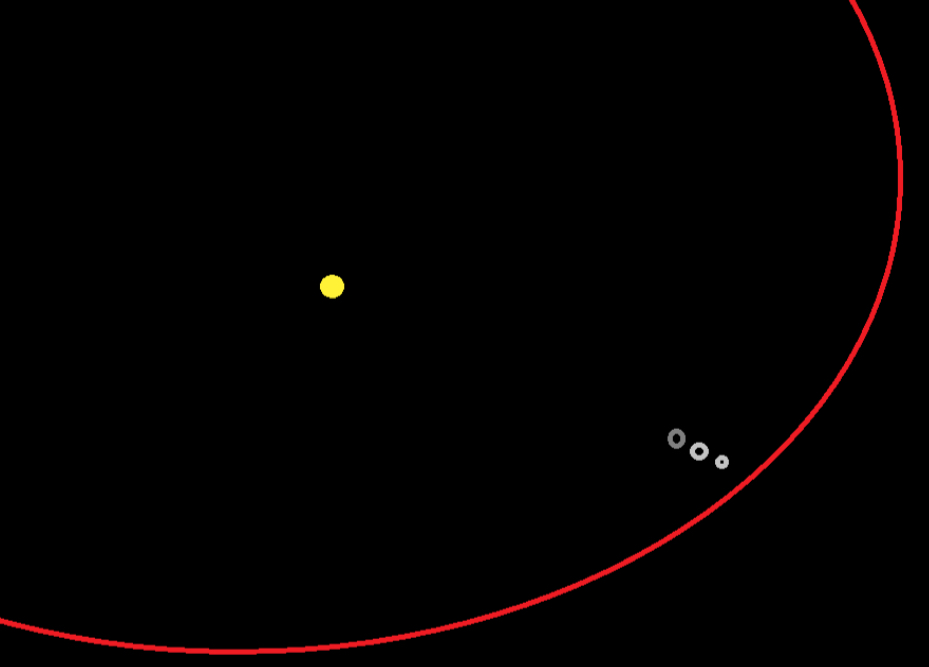
Fig. 2: Differentiation of orbits according to mass.
Over the years, the shower gradually loses its symmetry. There are two parameters, derived from visual observation, that analytically describe this phenomenon:
- The meteoric flux density.
- The mass index.
The meteor flux density is indicated by Q(m0) and is defined as the quantity of meteoroids of mass m0 per unit of time, in a unit of area perpendicular to the direction of motion.
For example, for m0 = 10 mg, we can have Q(m0) = 0.001 billionths per square meter per second.
The mass index is the exponent (s) in a power distribution of meteoroid masses, a method for modeling the number of meteoroids of different sizes that exist. The formula is:
dN/dM = N₀(M/M*)⁻ˢ
where dN is the number of meteoroids in a mass interval dM, N₀ is a constant, M* is a characteristic mass, and s is the mass index. (2)
The following plot shows the comparison between Q(m0) and s for a generic shower: the x-axis represents the solar longitude, i.e., time.
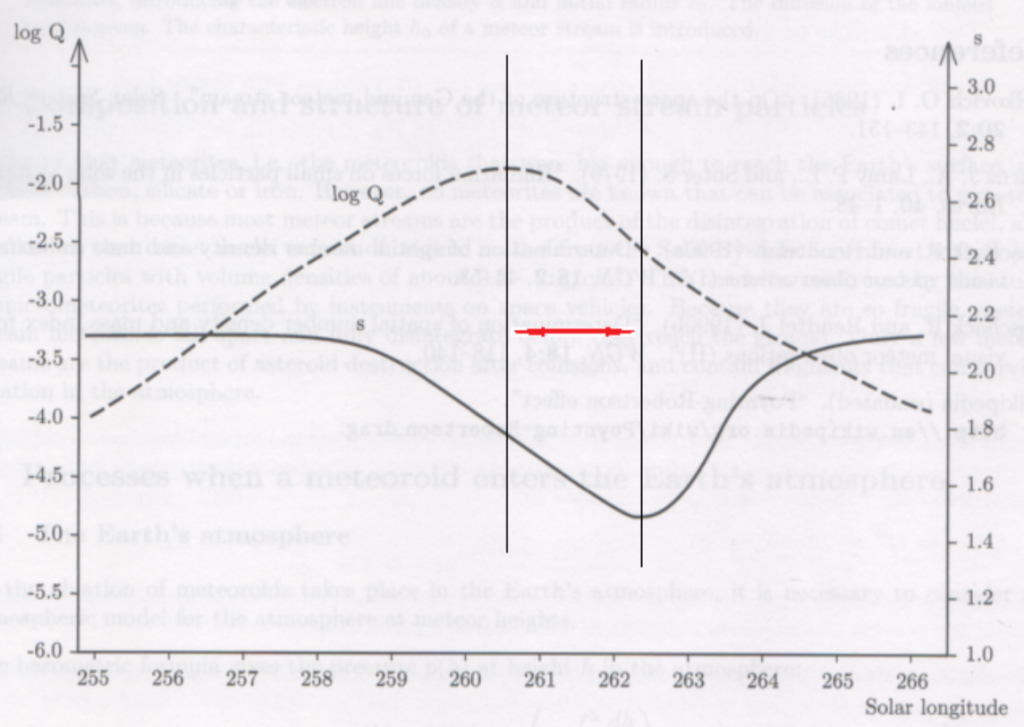
Fig. 3: Comparison between Q(m0) and s in a generic meteor shower. (2).
The difference between the maximum of Q(m0) and the maximum of s represents the time interval between the maximum particle density and the maximum of the more massive particles, and is proportional to the age of the shower: the younger the shower, the more the length of the red arrow in fig. 3 tends towards zero.
To complicate matters, we must consider the inclination of the orbits, which changes the way the Earth encounters the shower (see fig. 4).
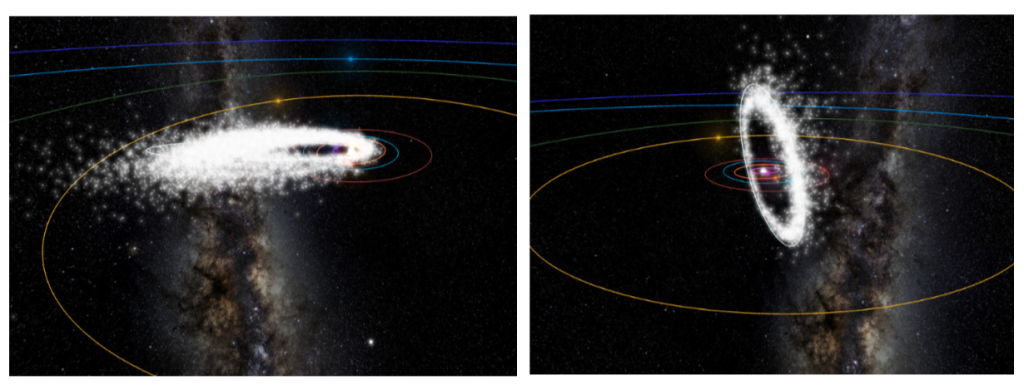
Fig.4: Low inclination orbit on the ecliptic (left) and high inclination orbit (right, with progenitor body originating from the Kuiper belt).
CARMELO, analyzing the number of recorded events, produces the Hourly Rate (HR, in red here) plot. This plot does not distinguish between different showers or between showers and sporadic meteors, but assuming that on days when a particular shower is active, the majority of radio meteors recorded belong to that shower, it can be considered, with a high degree of approximation, that this data is comparable to the Q(m0) calculated from visual observations.
The same page also shows the duration plot (in blue), which records the duration of the radio signals received by the CARMELO receivers. These durations depend on the degree of saturation of the cylinder of free electrons formed by the impact of the meteor with the molecules of the ionosphere.
There are many variables that determine the degree of saturation of a radiometeor, including: velocity (squared), mass, cross section (i.e., size), altitude of the point of specular reflection, frequency, transmitter power, receiver impedance, gains of the two antennas, and atmospheric pressure. (3)
In order to simplify the search for the predominant quantities, we can roughly state that the share of point P of specular reflection, the frequency, the transmitter power, the receiver impedance, and the gains of the two antennas are always the same, and ignore atmospheric pressure. In the case of a shower, speed can also be ignored, considering that the particles belonging to it impact the atmosphere at the same speed and therefore, even with gross simplifications, we can try to consider the duration of the echoes as comparable to the mass index s.
In the image below, we propose a comparison between the Hourly Rate and duration in the case of the Quadrantids.
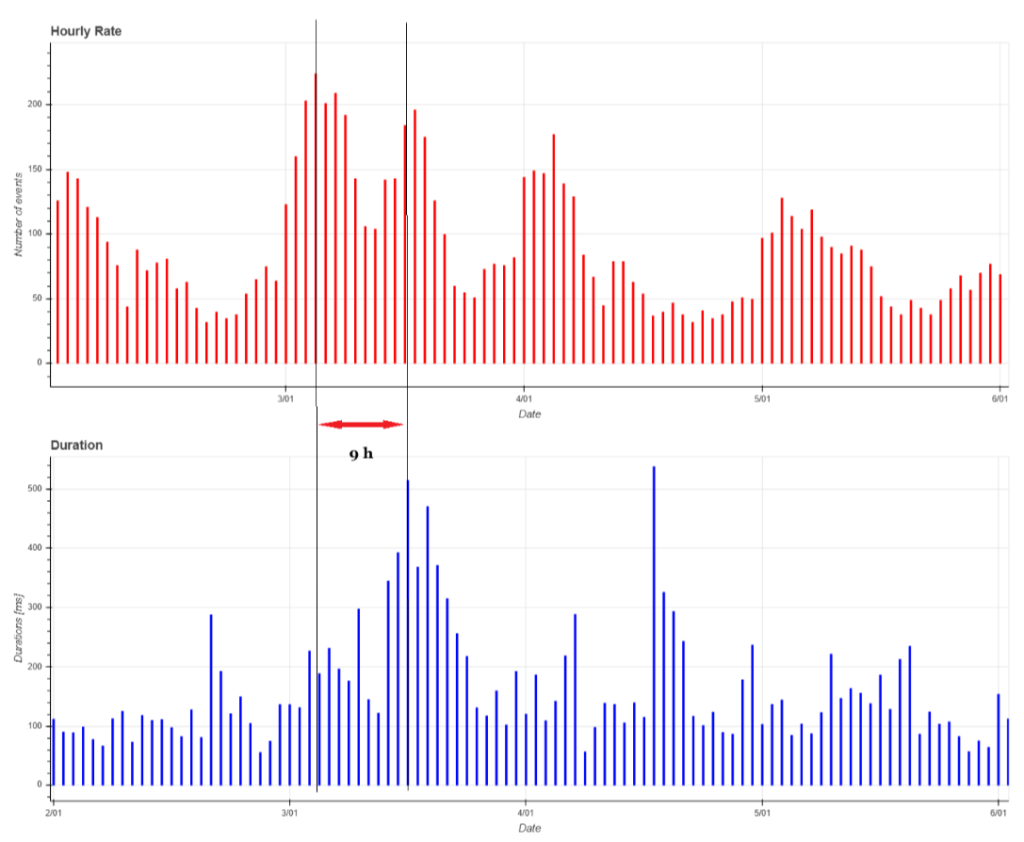
Fig. 5: Comparison between HR and duration, in the case of the Quadrantids.
This is a notoriously “young” shower, but even at its age, a noticeable discrepancy between the two maxima can be observed.
Assuming that these considerations have a scientific basis despite the simplifications made, we could also go so far as to estimate the order of magnitude of the distances involved.
Considering that:
s=v*t
and that the speed v of the Earth in the Solar System is approximately 30 km/s, in 9 hours the distance traveled will be:
s=30*9*60*60 = 972000 Km
In other words, the shift toward an inner orbit by the most massive particles resulted in a distance between orbits of the order of magnitude of one million kilometers.
The reliability of the comparison we propose here will need to be verified in the future with other showers.
The CARMELO network
The network currently consists of 14 receivers, 13 of which are operational, located in Italy, the UK, Croatia and the USA. The European receivers are tuned to the Graves radar station frequency in France, which is 143.050 MHz. Participating in the network are:
- Lorenzo Barbieri, Budrio (BO) ITA
- Associazione Astrofili Bolognesi, Bologna ITA
- Associazione Astrofili Bolognesi, Medelana (BO) ITA
- Paolo Fontana, Castenaso (BO) ITA
- Paolo Fontana, Belluno (BL) ITA
- Associazione Astrofili Pisani, Orciatico (PI) ITA
- Gruppo Astrofili Persicetani, San Giovanni in Persiceto (BO) ITA
- Roberto Nesci, Foligno (PG) ITA
- MarSEC, Marana di Crespadoro (VI) ITA
- Gruppo Astrofili Vicentini, Arcugnano (VI) ITA
- Associazione Ravennate Astrofili Rheyta, Ravenna (RA) ITA
- Akademsko Astronomsko Društvo, Rijeka CRO
- Mike German a Hayfield, Derbyshire UK
- Mike Otte, Pearl City, Illinois USA
The authors’ hope is that the network can expand both quantitatively and geographically, thus allowing the production of better quality data.
References
(1) P. Jenniskens (2006): “Meteor showers and their parent comets”. Cambridge University Press
(2) O. Belkovich, D. Pajovic, J M. Wislez (2005): “Basic elements of meteor stream theory”. Proceedings of the radio meteor school 2005, from p. 17.
(3) O. Belkovich, Cis Verbeeck (2005): “The physics of meteoroid ablation and the formation of ionized meteor trails”. Proceedings of the radio meteor school 2005, from p. 21.

